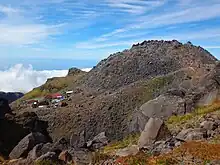
Shinkai (神階, "divine rank") is a system of ranking kami in Shinto.[1][2][3] Higher rank meant more lands were given to the shrine and it became wealthier and more powerful.[1]
History
The Shinkai system was linked to the Myōjin and ranked deity shrine systems. The Myojin system ranked deities and the Kanpei kokuhei-sha system ranked shrines. Its goal was to control important shrines for the state.[2]
At first, the state shrine system did not work well. It was meant for festivals for Japan's deities. At that time only a few state shrines existed. Their numbers started to grow in the mid-eighth century. This was because of changes in local governance. These changes were part of the Ritsuryo system.[2]
The first mention of shinkai is in the Tôdaiji yôroku. This document is from around 1134. It says that in 746, Hachiman Taisha got the third rank. This was to help an ill emperor.[1]
The earlier Hanpei system was about giving festival materials (heihaku) to shrines. The system got stricter. Shinto priests who did not collect heihaku faced penalties, but this did not work well.[2]
The system changed a lot in the late eighth century under the Ritsuryo system. Many thought the Department of Divinities was losing power. But the number of state-supported shrines grew.[2]
During the Enryaku era, the Department of Divinities made two important changes:[2]
- Specially Designated Shrines and Deities: This system managed some shrines (Kanpei-kokuhei-sha) and deities (Myojin). The Bureau managed them directly in the Kinai region. Provincial governors (Kokushi) managed them in other regions.[2]
- Increased Control: Provincial governors tried to get more control. They applied for recognition from the Bureau. They also asked for Heihaku.[2]
By the late eighth century, it was common to give status and rankings to shrines. This created a clear hierarchy. Governors and local leaders supported this.[2] Governors liked it for control. Local leaders liked it for political status.[2]
For example In history every time Mount Chokai erupted, the rank of Omonoimi no Kami the kami of Chōkaisan Ōmonoimi Shrine[4] was increased.[5] Omonoimi no Kami is known to have received the rank of Shōichii in the reign of Emperor Yōmei..[6]
At first, shrines got land based on rank. Higher ranks meant more land.[1]
Governors gradually got more control over shrine ranking. Ranking gods became mainly a provincial matter. The central government was little involved.[2]
Later, the practice changed. It became more ceremonial and less practical.[1]
The system ended in the Meiji period.[1]
See also
References
- 1 2 3 4 5 6 "Basic Terms of Shinto: Shinkai". www2.kokugakuin.ac.jp. Retrieved 2023-11-11.
- 1 2 3 4 5 6 7 8 9 10 11 慈司, 小倉 (1994). "八・九世紀における地方神社行政の展開 (English language abstract only)". 史学雑誌. 103 (3): 390–415, 476–47. doi:10.24471/shigaku.103.3_390.
- ↑ "SHIGAKU ZASSHI". www.jstage.jst.go.jp. Retrieved 2023-11-27.
- ↑ "chokaizan omonoimi shrine(warabioka kuchi no miya) - shrine-heritager". shrineheritager.com. Archived from the original on 2023-11-11. Retrieved 2023-04-25.
{{cite web}}: CS1 maint: unfit URL (link) - ↑ Fukada, Kyūya (2014-12-31). One Hundred Mountains of Japan. University of Hawaii Press. p. 76. ISBN 978-0-8248-4785-2.
- ↑ Fukada, Kyūya (2014-12-31). One Hundred Mountains of Japan. University of Hawaii Press. p. 76. ISBN 978-0-8248-4785-2.